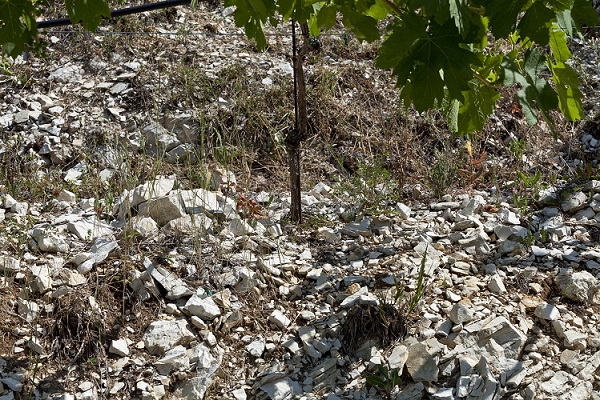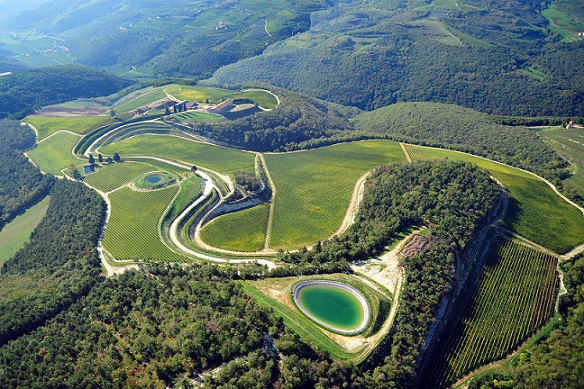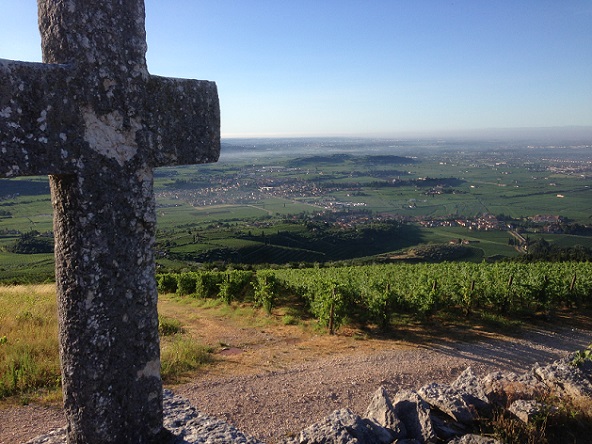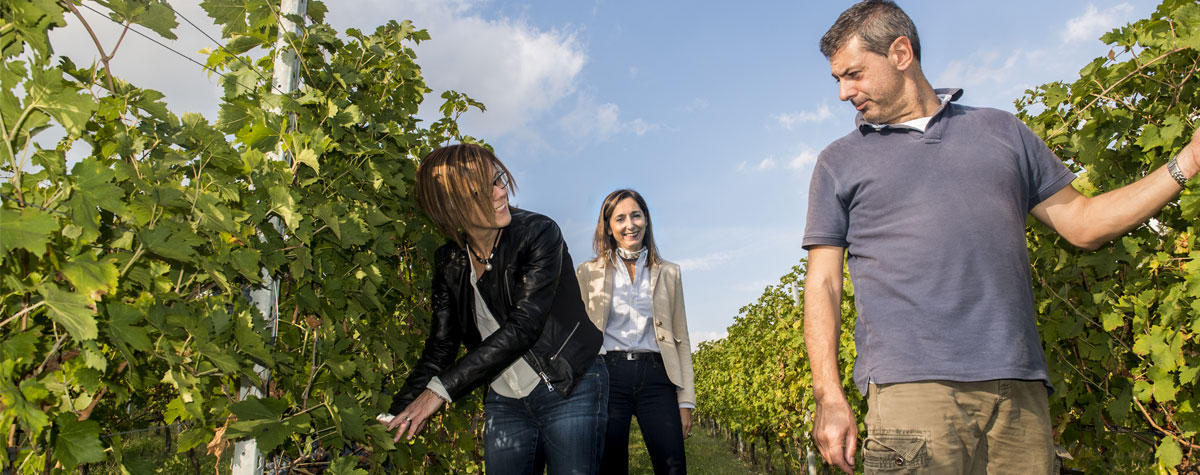The extensive soil mapping and zoning research the family started ten years ago has spurred the famed Valpolicella, Amarone and Recioto producer – now in the hands of fifth-generation Riccardo, Antonietta and Sabrina Tedeschi – to make two excellent, age-worthy, single-vineyard Valpolicella Superiore wines from its Maternigo and La Fabrisiera sites.
“With these wines, we try to explain what is possible with fresh grapes,” said Sabrina, who’s in charge of marketing. “By making a special selection in the vineyards, we can also make a Valpolicella of longer ageing potential.”

Zoning research
In 2010 Riccardo Tedeschi, now the winemaker at the family estate, started researching the soil in the organically farmed vineyards at their new Maternigo estate, bought in 2006, and in the Classico zone.The region’s soils are complex, reflecting their diverse origins. The limestone deposits and fossils found throughout come from the period – more than 100 million years ago – when this area was under the sea. The basalt tufa in the hills of upper Valpolicella comes from the tertiary period, when there were underwater volcanoes. The huge glaciers, which carved out the valleys and created Italy’s largest lake, Lake Garda, left the alluvial glacial and river deposits on the valley floors.
It took four years, from 2010 to 2013, to complete the study. As expected, it revealed a significant variability in soil profile – and also in the carbon-to-nitrogen ratio, vine growth and skin-to-flesh ratio.
- The carbon-to-nitrogen ratio is important because it shows soil fertility. If the carbon-to-nitrogen ratio is very high, the material left on the surface (cut shoots, decomposing cover crop, etc) will decompose very slowly, leading to the accumulation of organic matrices making the soil more fertile and hospitable for vine roots. On the other hand, if the carbon-to-nitrogen ratio is low, organic material will decompose faster and the soil could become impoverished.
- Studying the vine growth enabled them to assess the condition of the vines and to target vines which were out of balance.
- The skin-to-flesh ratio showed which areas of the vineyards produce the healthiest bunches with a large quantity of small berries (important for the wine's aroma).
- Cover cropping to strengthen the natural defences of the vineyard;
- Creating a plan for the control of water stress;
- Increasing the amount of organic carbon content;
- And enriching the terrain by sowing specific plants and spreading organic fertilisers.
“The research has allowed us to gain a deep knowledge about our terrain, the microclimate and the manner in which individual plants respond, and in this way has led us to manage the different zones of the vineyard in a more targeted fashion, thus reducing to a bare minimum any emergency intervention,” Riccardo explained to Canopy.
Sabrina added: “It is always better to work in the vineyards and make the harvest as late as possible because in this way we can better explain the terroir. Because if you are able to better explain the terroir you can make wines with much more character.”

Maternigo
The estate (above), which lies in the hills between the municipalities of Tregnago and Mezzane di Sotto in the Valpolicella DOC area, covers 84ha, of which 31 are currently planted to vines.The soil mapping uncovered “real crus” here, according to Riccardo. One of these is the 3ha Impervio vineyard, so called because of its steep slope (up to 35 degrees).
Here, the soil produces vines with low vegetative vigour and smaller bunches. The favoured position, steep terrain and low humidity during most of the growth cycle encourage the slow ripening of healthy grapes, leading to a wine with a high concentration of dry extract (37g/L), considerable tannic structure, refreshing acidity (5.7g/L) and a level of alcohol that ensures excellent ageing potential (15%).
Riccardo said that, in Maternigo, “the presence of ferrous oxide and magnesium brings out more pronounced notes of red fruit and pepper and favours the Corvina and Corvinone varieties, which are included in greater quantities in the Valpolicella blend”.
He added: “In addition to a good aromatic intensity, the Valpolicella Maternigo also exhibits a lively acidity, which allows for a long maceration, allowing for good phenolic extraction.”
Vineyard notes
Soil: white and yellow limestone marls of moraine origin, at 400m above sea level
Vine density: an average of 5,000 vines per hectare
Vineyard age: 10 years
Cultivation: Guyot
Pruning: 10-12 buds/plant
Production: 7,000kg/ha
Grape varieties: 40% Corvina, 40% Corvinone, 20% Rondinella
Winemaking
Harvest: overripe grapes picked around mid/end of October
Crushed and destemmed
Alcoholic fermentation and long maceration: 20 days at 20-23°C
Maturation: in 20-25hl Slavonian oak casks for 14 months
Blended
Bottled
Bottle ageing: 6 months
Production: about 15,000 bottles
The wine
Colour: deep ruby red, clear and bright
Bouquet: very pronounced fruit. Notes of redcurrants, cherries and plums that give freshness to the wine and meld with mineral, ethereal, spicy and vanilla-like hints.
Taste: rich, fresh and well-balanced fruit. The concentration of the dry extract is notable and admirably set off by considerable tannic structure, very lively acidity and a level of alcohol that ensures good ageing potential. The flavours echo those on the nose. This is a long, fresh, concentrated and very elegant wine.

La Fabriseria
Planted at the beginning of the 2000s, this 7ha vineyard (above) is situated on a hill in Le Pontare (between the municipalities of Sant’Ambrogio di Valpolicella and Fumane).Following the soil study, the easy-drinking Rosso La Fabriseria was reconfigured and is now a Valpolicella DOC Classico Superiore. The Cabernet Sauvignon in the blend of Corvina, Corvinone and Rondinella was replaced with a small percentage of local grape Oseleta.
Riccardo explained: “The soil in the Fabriseria vineyard produces more concentrated varieties that are brought into balance with the Oseleta variety, which typically has a strong character that would tend to overpower the Corvina and Corvinone.”
Another change was reducing the yield per hectare to Amarone levels – 6,400kg/ha.
The grapes are picked late for the region and the wine is aged in large Slavonian oak barrels (1,000-5,000L). Sabrina said they are pleased with the quality and porosity of Slavonian oak and feel it produces “more elegant wines without a lot of oak character”. She told Canopy: “We have some oak character but it is very, very soft because we like to explain better and better the terroir – the fruity characteristics – of our varieties.”
Vineyard notes
Soil: clay and calcareous of moraine origin
Vine density: 7,200 vines per hectare
Vineyard age: 16 years
Cultivation: Guyot
Pruning: 10-12 buds/plant
Yield: 6,400kg/ha
Grape varieties: 40% Corvina, 40% Corvinone, 15% Rondinella, 5% Oseleta
Winemaking
Harvest: overripe grapes picked around mid/end of October
Vinification: a portion of whole grapes with stems
Alcoholic fermentation and maceration: 30 days/temperature 20-23°C
Ageing: in Slavonia oak barrels (10 hl) for 24 months.
Blended
Bottled
Bottle ageing: 6 months
The wine
Colour: intense ruby red, clear and transparent
Bouquet: hints of blackcurrant, sour cherry, cherry, and prune gives freshness to the wine and is combined with hints of minerals and vanilla
Taste: rich structure and balance. The extract concentrate (35.9g/L) is revealing and well balanced by a significant tannic structure, by a lively acidity (6.1g/L) and by an alcohol content (15%) that ensures a good ageing potential. The flavour confirms the notes on the nose. This is an elegant wine with a long finish.
The link between wine aroma and soils
One of the findings of ongoing research Tedeschi is undertaking with the Department of Biotechnology at the University of Verona is that land composition is one of the factors influencing the aroma of wine.Riccardo said: “From the results obtained so far we know that the volatile compounds that give life to fruity aromas are among the main markers of the diversity among the vineyards and appear to be more present in the grapes coming from Monte Olmi (their flagship Amarone vineyard) and La Fabriseria. The wines obtained in the Maternigo area, on the other hand, have an evident smell of peach, cooked fruit and sweet spices.”
Findings
- At Maternigo, the soil is yellowish grey marl with large amounts of iron and manganese oxides – which, it is said, release hints of spice and red fruit (black cherry and cherry). The sandy soils (35/40%) give hints of berries (blackcurrant and raspberry), while the presence of limestone “ensures a high aroma content”.
- At La Fabriseria, the soils are characterised by whitish pink marl, rich in calcium carbonate and iron oxide, producing wines of great structure and good balance. The sand content enhances characteristics of finesse, fresh, fruity notes and persistence, while the topsoil favours balanced, age-worthy wines.













.png)






